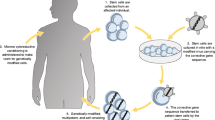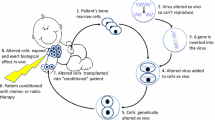Abstract
The efforts to find satisfactory treatments for seriously ill patients with primary immunodeficiency have resulted in the development of important new therapeutic procedures with benefits reaching far beyond the relatively small number of patients affected with these rare disorders. Allogeneic bone marrow transplantation, immunoglobulin and enzyme replacement treatments and more recently gene therapy have all been introduced into clinical medicine as treatments for one or more of the primary immunodeficiency diseases. Beginning in 1990, gene-corrected T cells were first used to treat ADA deficiency SCID. With this demonstration that the gene-transfer procedure could be safely used to introduce functional transgenes into patient cells, clinical trials for a broad range of inherited disorders and cancer were started in the mid 90s. Of all these early clinical experiments, those addressing primary immunodeficiency have also been the most successful. Both ADA and X-SCID have now been cured using gene insertion into autologous bone marrow stem cells. In addition some patients with chronic granulomatous disease (CGD) have shown an unexpectedly high level of functionally corrected granulocytes in their blood following infusion of autologous gene-corrected bone marrow. There remain however a great many significant challenges to be overcome before gene therapy becomes the treatment of choice for these and other disorders. The use of genes as medicines is the most complex therapeutic system ever attempted and it may rake several more decades of work before its real potential as a treatment for both inherited and sporadic disorders if finally realized.
Similar content being viewed by others
References
Rosenberg SA, Aebersold P, Cornetta K, Kasid A, Morgan RA, Moen R, et al. Gene transfer into humans: immunotherapy of patients with advanced melanoma using tumor infiltrating lymphocytes modified by retroviral gene transduction. New Engl J Med 1990;323:570–78.
Gillio A, Bordignon C, Kernan N, Kantoff P, Eglitis M, McLachlin J, et al. Retroviral-mediated gene transfer and expression in nonhuman primates following autologous bone marrow transplantation. In: Peschle C, editor. Normal and neoplastic blood cells: from genes to therapy. Ann NY Acad Sci 1987;511:406–17.
Hershfield MS, Buckley RH, Greenberg ML, et al. Treatment of adenosine deaminase deficiency with polyethylene glycol-modified adenosine deaminase. N Engl J Med 1987;316:589–96.
Blaese RM, Culver KW, Miller AD, Carter CS, Fleisher T, Clerici M, et al. T Lymphocyte-directed gene therapy for ADA deficiency SCID: initial trial results after 4 years. Science 1995;270:475–80.
Muul LM, Tuschong LM, Soenen SL, Jagadeesh GJ, Ramsey WJ, Long Z, et al. Persistence and expression of the adenosine deaminase gene for 12 years and immune reaction to gene transfer components: long-term results of the first clinical gene therapy trial. Blood 2003;101:2563–9.
Tuschong L, Soenen SL, Blaese RM, Candotti F, Muul LM. Immune response to fetal calf serum by two adenosine deaminase-deficient patients after T cell gene therapy. Hum Gene Ther 2002;13:1605–10.
Bordignon C, Notarangelo LD, Nobili N, Ferrari G, et al. Gene therapy in peripheral blood lymphocytes and bone marrow for ADA(−) immunodeficient patients. Science 1995;270:470–5.
Hoogerbrugge PM, van Beusechem VW, Fischer A, Valerio D. Bone marrow gene transfer in three patients with adenosine deaminase deficiency. Gene Ther 1996;3:179–83.
Kohn DB, Weinberg KI, Nolta JA, Heiss LA, Lenarsky C, Crooks GM, et al. Engraftment of gene-modified umbilical cord blood cells in neonates with adenosine deaminase deficiency. Nature Med 1995;1:1017–28.
Kohn DB, Hershfield MS, Carbonaro D, Shigeoka A, Brooks J, Smogorzewska EM, Barsky LW, et al. T␣lymphocytes with a normal ADA gene accumulate after transplantation of transduced autologous umbilical cord blood CD34+ cells in ADA-deficient SCID neonates. Nature Med 1998;4:775–80.
Aiuti A, Slavin S, Aker M, et al. Correction of ADA-SCID by stem cell gene therapy combined with nonmyeloablative conditioning. Science 2002;296:2410–3.
Soudais C, Shiho T, Sharara LI, Guy-Grand D, Taniguchi T, Fischer A. Stable and functional lymphoid reconstitution of common cytokine receptor gamma chain deficient mice by retroviral-mediated gene transfer. Blood 2000;95:3071–7.
Cavazzana-Calvo M, Hacein-Bey S, de Saint Basile G, et al. gene therapy of human combined immunodeficiency (SCID)-X1 disease. Science 2000;288:669–72.
Hacein-Bey-Abina S, Von Kalle C, Schmidt M, et al. LMO2-associated clonal T cell proliferation in two patients after gene therapy for SCID-X1. Science 2003;302:415–20.
Gaspar BH, Parsley KL, Howe S, et al. Gene therapy of X-linked severe combined immunodeficiency by use of a pseudotyped gammaretroviral vector. Lancet 2004;364:2181–7.
Malech HL, Choi U, Brenner S. Progress toward effective gene therapy for chronic granulomatous disease. Jpn J Infect Dis 2004;57:S27–8.
Ott MG, Schmidt M, Schwarzwaelder K, et al. Correction of X-linked chronic granulomatous disease by gene therapy, augmented by insertional activation of MDS1-EVI1, PRDM16 or SETBP1. Nature Med 2006;12:401–9.
Grez M, American Society of Gene Therapy annual Meeting, June 2006, Baltimore.
Urnov FD, Miller JC, Lee YL, Beausejour CM, Rock JM, Augustus S, et al. Highly efficient endogenous human gene correction using designed zinc-finger nucleases. Nature 2005;435:646–51.
Author information
Authors and Affiliations
Corresponding author
Additional information
Presented at the First Robert A Good Society Symposium, St. Petersburg, FL 2006.
Rights and permissions
About this article
Cite this article
Blaese, R.M. What is the status of gene therapy for primary immunodeficiency?. Immunol Res 38, 274–284 (2007). https://doi.org/10.1007/s12026-007-0009-z
Published:
Issue Date:
DOI: https://doi.org/10.1007/s12026-007-0009-z




